Related Research Articles

Free Tibet (FT) is a non-profit, non-governmental organisation, founded in 1987 and based in London, England. According to their mission statement, Free Tibet advocates for "a free Tibet in which Tibetans are able to determine their own future and the human rights of all are respected."
Tibetan Freedom Concert is the name given to a series of socio-political music festivals held in North America, Europe and Asia from 1996 onwards to support the cause of Tibetan independence. The concerts were originally organized by Beastie Boys and the Milarepa Fund. The idea for a Live Aid-style concert for Tibet was conceived by members of the group during the 1994 Lollapalooza Tour.

The 1959 Tibetan uprising began on 10 March 1959, when a revolt erupted in Lhasa, the capital of Tibet, which had been under the effective control of the People's Republic of China (PRC) since the Seventeen Point Agreement was reached in 1951. The initial uprising occurred amid general Chinese-Tibetan tensions and a context of confusion, because Tibetan protesters feared that the Chinese government might arrest the 14th Dalai Lama. The protests were also fueled by anti-Chinese sentiment and separatism. At first, the uprising mostly consisted of peaceful protests, but clashes quickly erupted and the Chinese People's Liberation Army (PLA) eventually used force to quell the protests. Some of the protesters had captured arms. The last stages of the uprising included heavy fighting, with high civilian and military losses. The 14th Dalai Lama escaped from Lhasa, while the city was fully retaken by Chinese security forces on 23 March 1959. Thousands of Tibetans were killed during the 1959 uprising, but the exact number of deaths is disputed.
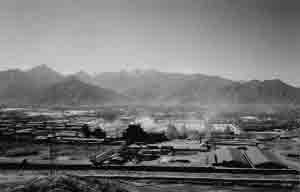
Drapchi Prison, or Lhasa Prison No. 1, is the largest prison in Tibet, China, located in Lhasa. Drapchi is named after its location and was originally a military garrison until it was converted into a prison after the 1959 Tibetan Uprising. It is roughly one mile from the city centre and is the main prison for judicially sentenced prisoners in Tibet. It was the primary place for the detention of political prisoners before 2005 when the newer and modernised Chushur Prison was built. Drapchi also goes by the name Delapuxie prison, which has sometimes been listed as a separate prison online.
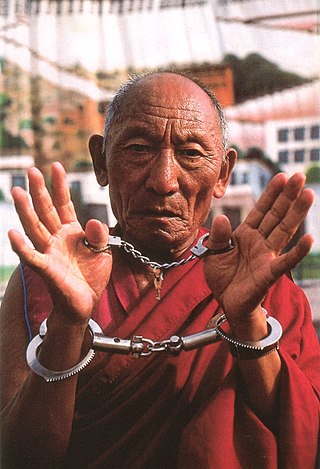
Palden Gyatso was a Tibetan Buddhist monk. Arrested for protesting during the Chinese invasion of Tibet, he spent 33 years in Chinese prisons and labor camps, where he was extensively tortured, and served the longest term of any Tibetan political prisoner. After his release in 1992 he fled to Dharamsala in North India, in exile. He was still a practicing monk and became a political activist, traveling the world publicizing the cause of Tibet up until his death in 2018. His autobiography Fire Under the Snow is also known as The Autobiography of a Tibetan Monk. He was the subject of the 2008 documentary film Fire Under the Snow.

The 2008 Tibetan unrest, also referred to as the 2008 Tibetan uprising in Tibetan media, was a series of protests and demonstrations over the Chinese government's treatment and persecution of Tibetans. Protests in Lhasa, the capital of Tibet, by monks and nuns on 10 March have been viewed as the start of the demonstrations. Numerous protests and demonstrations were held to commemorate the 49th anniversary of the 1959 Tibetan Uprising Day, when the 14th Dalai Lama escaped from Tibet. The protests and demonstrations spread spontaneously to a number of monasteries and throughout the Tibetan plateau, including into counties located outside the designated Tibet Autonomous Region.

Tibetan Uprising Day, observed on March 10, commemorates the 1959 Tibetan uprising which began on March 10, 1959, and the Women's Uprising Day of March 12, 1959, involving thousands of women, against the presence of the People's Republic of China in Tibet.
The 1987–1989 Tibetan unrest was a series of protests and demonstrations that called for Tibetan independence. These protests took place between September 1987 and March 1989 in the Tibet Autonomous Region, in the Tibetan regions of Sichuan, and Qinghai, as well as the Tibetan prefectures in Yunnan and Gansu. Protests began shortly after the Dalai Lama, the religious and temporal leader of Tibet exiled in India since the 1959 Tibetan unrest, proposed a Five Point Peace Plan regarding the "status of Tibet" on September 21, 1987, which was subsequently rejected by the Chinese government. The plan advocated for greater respect and autonomy of the Tibetan people, and claimed that "Tibet was a fully independent state when the People's Liberation Army invaded the country in 1949–50." China rejected the idea of Tibetans as an invaded people, stating that "Tibet is an inalienable part of Chinese territory" and has been for hundreds of years. The Tibetan sovereignty debate is longstanding, and the Tibetan assertion that they are a separate and unique people invaded by China has become a central argument for their independence.

In Sichuan province, in an area incorporating the traditional Tibetan areas Kham and Amdo, Tibetan monks and police clashed in riots on 16 March in Ngaba county (Aba) after the monks staged a protest. It formed part of the 2008 Tibetan unrest and was one of two major events to happen in Sichuan during 2008, the other being the 2008 Sichuan earthquake in May 2008.

The 14th Dalai Lama is the incumbent Dalai Lama, the highest spiritual leader and head of Tibetan Buddhism. Before 1959, he served as both the resident spiritual and temporal leader of Tibet, and subsequently established and led the Tibetan government in exile represented by the Central Tibetan Administration in Dharamsala, India. The adherents of Tibetan Buddhism consider the Dalai Lama a living Bodhisattva, specifically an emanation of Avalokiteśvara or Chenrezig, the Bodhisattva of Compassion, a belief central to the Tibetan Buddhist tradition and the institution of the Dalai Lama. The Dalai Lama, whose name means Ocean of Wisdom, is part of the full title "圣 识一切 瓦齐尔达喇 达赖 喇嘛" given by Altan Khan, the first Shunyi King of Ming China in 1578 AD., is also known to Tibetans as Gyalwa Rinpoche, The Precious Jewel-like Buddha-Master, Kundun, The Presence, and Yizhin Norbu, The Wish-Fulfilling Gem. His devotees, as well as much of the Western world, often call him His Holiness the Dalai Lama, the style employed on his website. He is also the leader and a monk of the Gelug school, the newest school of Tibetan Buddhism, formally headed by the Ganden Tripa.
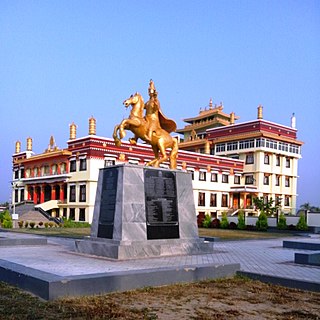
The Tibetan diaspora is the relocation of Tibetan people from Tibet, their country of origin, to other nation states to live as exiles and refugees in communities. The diaspora of Tibetan people began in the early 1950s, peaked after the 1959 Tibetan uprising, and continues.

Lodi Gyaltsen Gyari Rinpoche, Kasur Lodi Gyari or "as he is universally known to the Tibetan-speaking world, Gyari Rinpoche" was a Tibetan politician, and journalist who served as the 14th Dalai Lama's special envoy to the United States. Exiled to India in 1959, he was also the executive chairman of the International Campaign for Tibet.
Human rights in Tibet has been a subject of intense international scrutiny and debate, particularly since the annexation of Tibet by the People's Republic of China. Before the 1950s, Tibet's social structure was marked by inequality and described as a caste-like system or, controversially, as serfdom. Severe punishments, including permanent mutilation of body parts, were common, although capital punishment was banned in 1913. Muslim warlord Ma Bufang caused widespread destruction and deaths in Amdo, which is located northeast of Central Tibet.
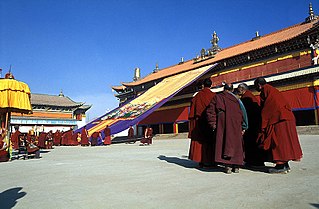
Kirti Gompa, is a Tibetan Buddhist monastery founded in 1472 and located in Ngawa, Sichuan province, in China, but traditionally part of Amdo region. Numerous other associated Kirti monasteries and nunneries are located nearby. As of March 2011, the Kirti Gompa was said to house 2,500 monks. Between 2008 and 2011, mass arrests and patriotic re-education programs by Chinese authorities have targeted the monks, reducing the population substantially to 600 monks. The wave of Tibetan self-immolations began at Kirti Gompa.

Protests and uprisings against the government of the People's Republic of China have occurred in Tibet since 1950, and include the 1959 uprising, the 2008 uprising, and the subsequent self-immolation protests.
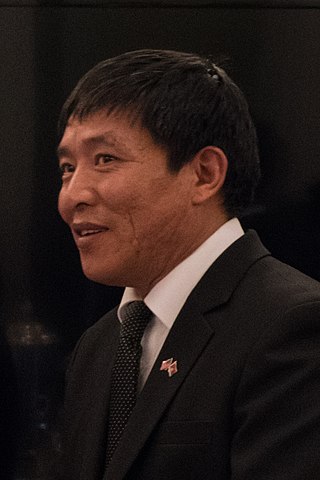
Dhondup Wangchen is a Tibetan filmmaker who had been imprisoned by the Chinese government in 2008 on charges related to his documentary Leaving Fear Behind. Made with senior Tibetan monk Jigme Gyatso, the documentary consists of interviews with ordinary Tibetan people discussing the 14th Dalai Lama, the Chinese government, the 2008 Beijing Olympics, and Han Chinese migrants to the region. After smuggling the tapes of the interviews out of Tibet, however, Dhondup Wangchen and Jigme Gyatso were detained during the 2008 Tibetan unrest.

Jigme Gyatso is a Tibetan activist of the Tibetan Independence Organisation who, in 1996, was sentenced to 15 years in prison on charges of "leading a counter-revolutionary organisation" and "inciting splittism". Two more years were added to his sentence in 2004 when he protested in jail. Several international human rights groups have protested or campaigned on his behalf, and Amnesty International has designated him a prisoner of conscience.

Lobsang Nyandak, sometimes written Lobsang Nyendak also called Lobsang Nyandak Zayul is a Tibetan diplomat and politician. born in 1965 in Kalimpong, India where he performed his studies in Herbertpur and at Panjab University in Chandigarh. There, he held functions at Tibetan Youth Congress before becoming the founding Executive Director of the Tibetan Centre for Human Rights and Democracy. Member of the National Democratic Party of Tibet, he was elected deputy and was selected as a minister by Samdhong Rinpoche, the first elected Kalon Tripa of Central Tibetan Administration (CTA). He then was the Representative of the 14th Dalai Lama to the Americas and became president of The Tibet Fund.

Chadrel Rinpoche was born in 1939 in Shigatse, Tibet. He was also known formally as Jadrel Jampa Thinley Rinpoche, and was a Gelug school Rinpoche of Tibetan Buddhism. In 1954, he joined the Tashilhunpo Monastery at the age of 15, and was forced to work in a labor camp during the Cultural Revolution in Tibet. He was a close student of Choekyi Gyaltsen, the 10th Panchen Lama. Later Chadrel Rinpoche became the head Khenpo of the Tashilhunpo Monastery. In 1989, Chadrel Rinpoche was appointed to lead the Chinese efforts to locate the reincarnated 11th Panchen Lama. In February 1995 while in Beijing, he refused plans to substitute the reincarnate Gedhun Choekyi Nyima with another boy. As a result, he was arrested after Gedhun Choekyi Nyima was formally recognized, then he was continually imprisoned and held under house arrest until his reported suspicious death from poisoning in 2011. He was also a Member of the 7th and 8th Chinese People's Political Consultative Conference (CPPCC).

Lobsang Tashi, also known as Khenchen Lobsang Tashi (1897–1966) was a Tibetan politician who was a senior monastic official and the monastic prime minister (sileun) of the Tibetan government during the early Chinese occupation of Tibet. After the departure of the 14th Dalai Lama in 1959, he was incarcerated in Drapchi Prison where he died in 1966.
References
- ↑ "Tibetan Centre for Human Rights and Democracy (TCHRD)". tibet.org. Tibet Online. Retrieved 13 December 2018.
- ↑ "Tibetan Centre for Human Rights and Democracy". hrwa.cul.columbia.edu. Columbia University, Human Rights Web Archive. Retrieved 13 December 2018.
- ↑ "Tibetan Center for Human Rights and Democracy". sourcewatch.org. The Center for Media and Democracy Source Watch. Retrieved 13 December 2018.
- ↑ Pinto, Kenya-Jade (6 September 2016). "Victoria: My summer at the Tibetan Centre for Human Rights and Democracy". Level, leveljustice.org. Retrieved 13 December 2018.
- ↑ Palden, Tenzin (16 December 2016). "A Worthy Learning Experience at TCHRD". Envision, Empowering the Vision Project. Retrieved 13 December 2018.
- ↑ Tashi, T. (18 July 2011). "TCHRD Organises Workshop on Human Rights and Democracy at Mundgod Tibetan Settlement". Central Tibetan Administration. Retrieved 13 December 2018.
- ↑ "Emory-Tibet Partnership, The Visit 2013". Emory University. Retrieved 22 October 2019.